Talking Tombstones

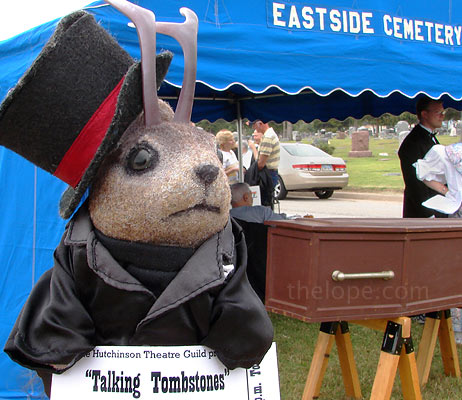
At thelope.com, we love the dead. They're a quiet folk...usually.
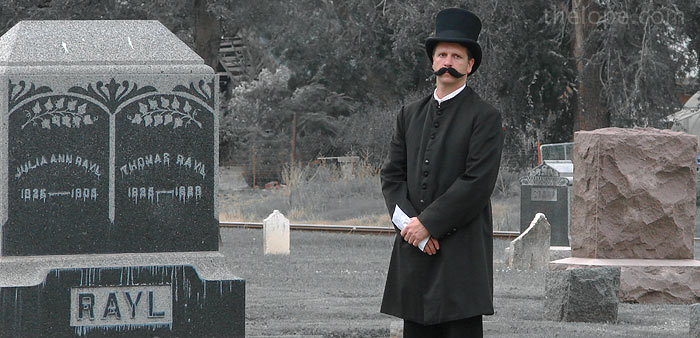
The Hutchinson Theatre Guild held its second annual Talking Tombstones fundraiser earlier this month and who could resist a walk through a cemetery? We couldn't. "Talking Tombstones" involved seven actors portraying seven departed Hutchinsonians whom visitors encountered on a walking tour through Eastside Cemetery.
Oh, I must confess I played with the color saturation on the above photo, leaving only red and a little cyan.
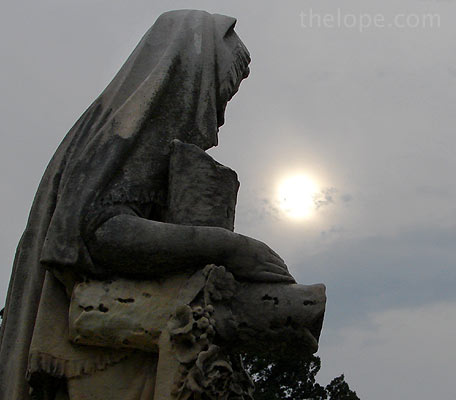
The day was mostly overcast and moody. The veiled sun shone behind the cemetery's only large statue.
Julia Campbell
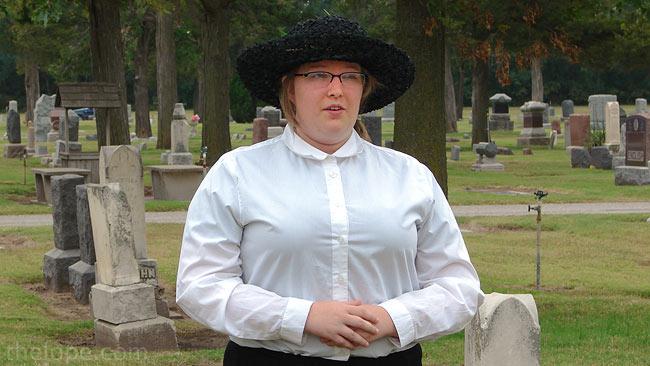
Rachel Adcock portrayed Julia Campbell, a homemaker for whose family Hutchinson's Campbell street is named. Her husband, Robert, was mayor of the town in 1891, but resigned when some of his appointments to city office were not approved. After that, he became City Attorney and eventually a judge.
Some interesting trivia Adcock gave about Hutchinson in 1891: population was 5,200; there were 10 churches, 24 telephones, 1,200 kids enrolled in elementary school, 75 in high school and The Hutchinson News had a circulation of over 1,000. Mrs. Campbell formed the first chapter of the Women’s Relief Corps in Hutchinson, an auxiliary to the Grand Army of the Republic, a civic organization. She died in 1931 of kidney problems.
Mary Collingwood
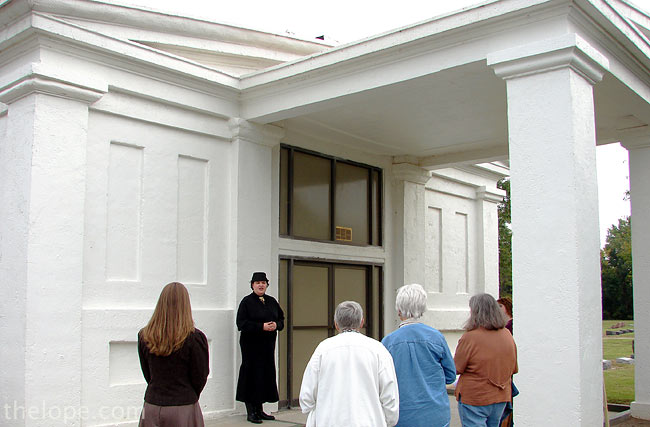
Shannon Knipp played Mary Collingwood, an early pioneer of Reno County.
The widow of a shoemaker, she moved with her nine children from Indiana to Kansas after her husband's death. She and five of her children filed claims in 1872 near a town she was asked to name - Pretty Prairie. They built a small frame house which became a stage and mail stop, as well as an outpost for hunters and frontiersmen.
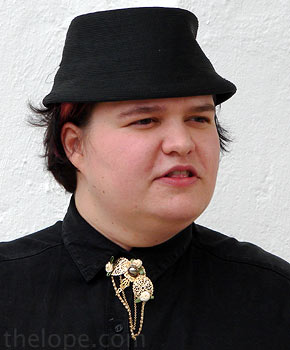
Knipp, as Collingwood, related:
"One night, a party of buffalo hunters – some professional men – were storm bound by a bad blizzard that struck as they reached Pretty Prairie. The storm was so severe that they had to spend several days at our home. The only warm place was around the cook stove and with all the visitors, there wasn’t enough room for everyone. The buffalo hunters pooled their money and paid my two youngest children a dollar and a half a day to stay in bed so they could get close enough to the stove to stay warm! It was the first cash money they ever earned."
She spoke of how she and her family increased their land holdings and built the business that would eventually become Collingwood Grain:
"In the early years, when a homesteader had had enough and complained that he’d trade his claim for a horse to “ride out of this godforsaken country” I was there with the horse."
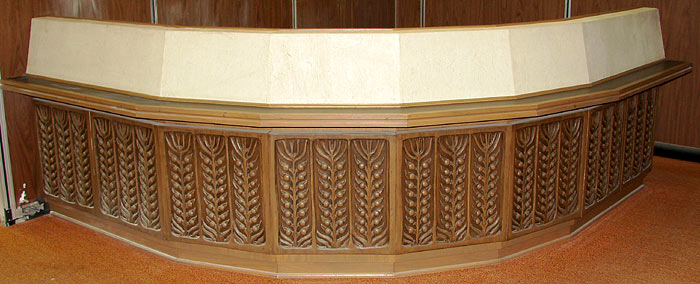
There is still a Collingwood grain elevator in Hutchinson, and the company once had an office (above) in the now nearly-abandoned Wiley Building.
Peter Tellin
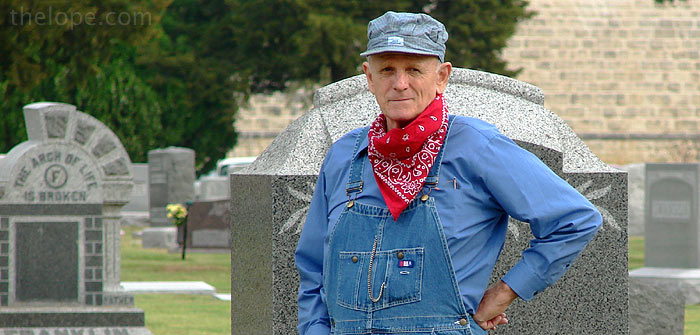
My favorite portrayal was that of Sparky Colladay as Peter Tellin, a Swedish emigrant born in 1845 who became a Santa Fe railroad engineer and drove the first train into Hutchinson.
He was instrumental in the Santa Fe winning an 1873 government land grant of two million acres by building track four feet into Colorado a mere ten minutes before the December 31 deadline.
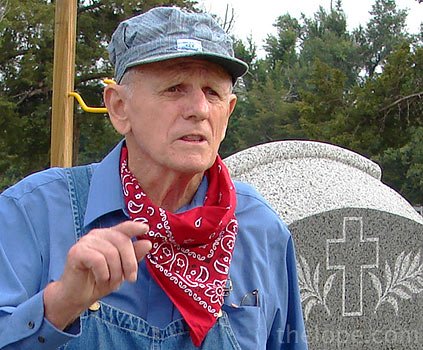
Colladay, as Tellin, related that sometimes grasshoppers were so thick as to slick up the track badly enough that it had to be sanded for traction. He also said that cowboys in Western Kansas would shoot the fire out of the train's lanterns so he often ran his engine in the dark.
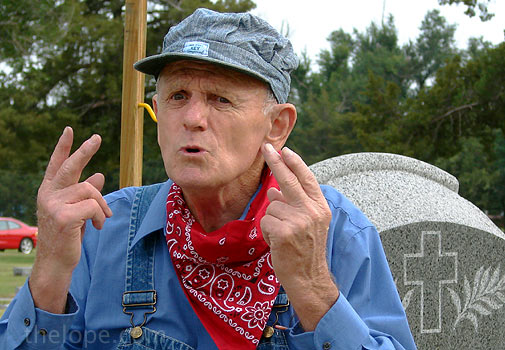
He is credited with averted two disasters that involved failed railroad bridges, saving the lives of passengers in the process.
Being a railroad engineer once required some frontier skills. In the winter of 1874-75 Tellin's train was stranded in a blizzard for a month, east of Dodge City. He and his crew had to hunt buffalo to feed the passengers.
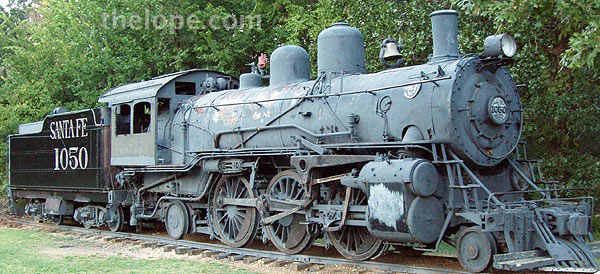
This Santa Fe Baldwin 2-6-2 locomotive was in use starting in 1902, ten years before Tellin's retirement in 1912. It is now preserved in Riverside Park in Independence, Kansas. Tellin died in 1941 at the age of 95. For many of the last years of his life he was considered the oldest living Santa Fe railroader.
A railroad track borders Eastside Cemetery; however, it belongs to Union Pacific.
Ghostville
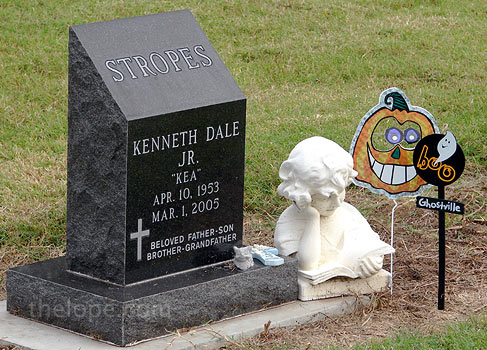
This was not part of the tour, but the grave of Kenneth Dale Stropes Jr. is decorated for Halloween and bears a sign that reads "Ghostville." Ya gotta like that.
G.A. Vandeveer
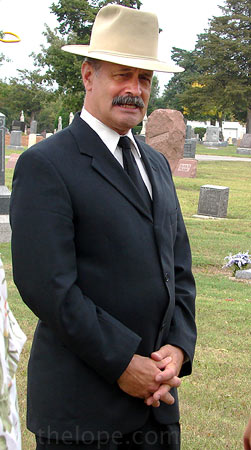
Joe McCarville portrayed G.A. Vandeveer, a banker and lawyer who came to Kansas in 1879. He was active in promoting Hutchinson and helped plan its celebration of the United States centennial in 1876.
He died in 1908 when his car was hit by a train running on tracks owned by the Rock Island, a railroad in which he was heavily invested.
The Union Pacific track that borders the cemetery once belonged to Rock Island.
K.E. Senteney
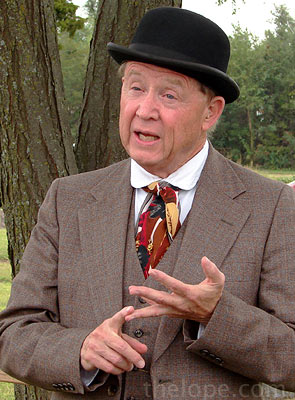
Craig Williams played K.E. Senteney, a man who moved to Kansas in 1900 and opened a wholesale grocery business with his brother. Their warehouse at 2nd and Poplar would eventually become Senteney Lofts, one of Hutchinson's more successful adaptive re-use projects.
Williams, as Senteney, related that when he was in business, sugar cost 4 cents a pound, eggs were 14 cents a dozen and coffee sold for 15 cents a pound.
He bought out his brother's interest in 1919, and later expanded his business interests to include Commercial National Bank, Hutchinson Interurban Railway Company and First National Bank.
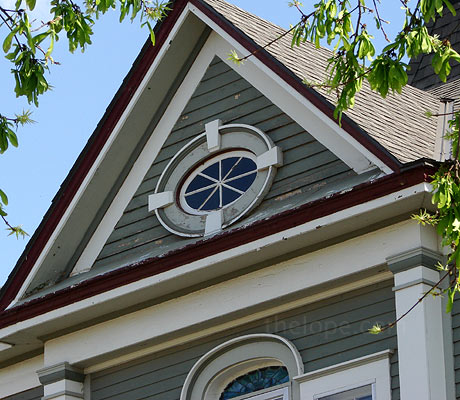
He died in his office in 1921. His home at 511 East Sherman (detail above) still stands.
Hamburger Gene
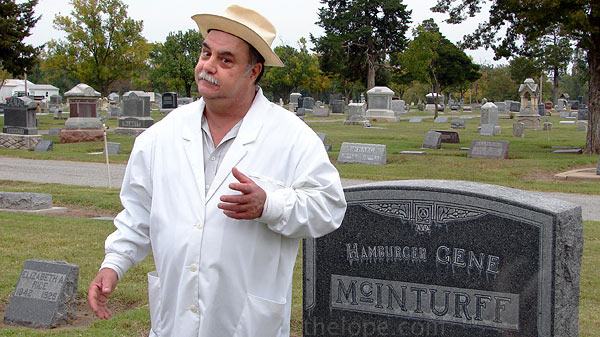
Steve Wilson portrayed "Hamburger Gene" McInturff, a person I wish was still around and in business.
Hamburger Gene operated a hamburger wagon on 1st and Main for 24 years, until the city chose not to renew his license, reportedly due to high demand for similar street cart licenses and the city's desire not to become cluttered with similar wagons. At the time, there were permit applications for a cold drinks stand at A & Main, a peanuts stand at 1st & Main and a shoe shine stand at 2nd & Main.
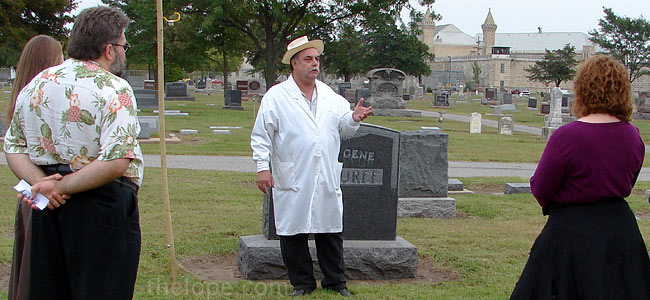
Hamburger Gene (I love typing that name) went into farm sales but still operated the wagon at the Kansas State Fair's Poplar entrance.
He was a silent partner in a photography business, McInturff Studio, with his brother, Austin. The studio once occupied the space that is now Hayden's hair salon in the Whiteside Building at 2nd and Main. The giant skylight which was intended to provide natural light, is still in place.
Cemetery Scene

While walking in a cemetery, inscriptions often jump out. "Affliction sore for years I bore. Physicians were in vain. At length God pleased to give me ease and freed me from my pain."
Alfred Ruben Scheble
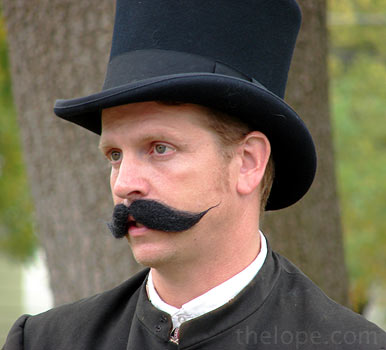
Bob Colladay played Alfred Ruben Scheble, a member of the Ohio State Assembly in the 1870s who moved a number of times to improve his health and eventually landed in Kansas. He became a partner in a law firm with the previously mentioned G.A. Vandeveer.
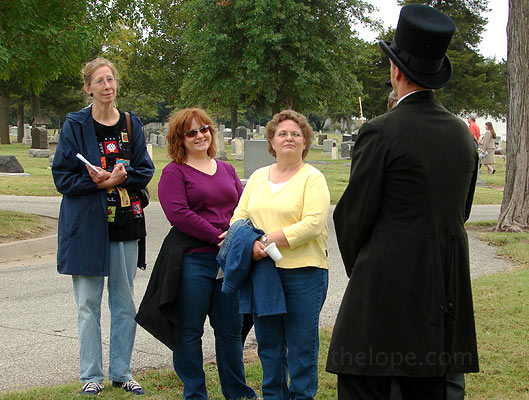
He served as a school board member and as editor and publisher of the Hutchinson Herald from 1879 until 1882. A Democratic, he won a seat in the Kansas State House in 1882, representing Reno County. Continually plagued by ill health, he died 3 days after Christmas in 1885.
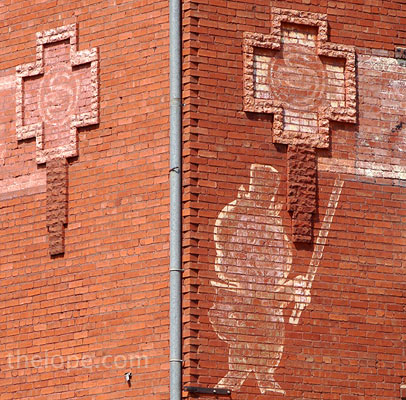
One of his sons, A.R. "Rube" Junior, opened the Richards-Scheble Candy Company with another family member. Rube died at the age of 49 when while working on a faulty freight elevator. Above is a detail from the building.
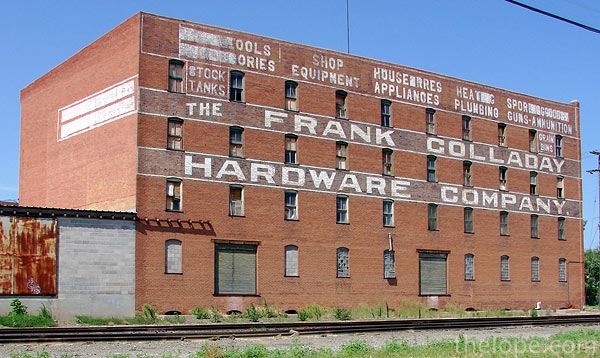
His daughter, Elma, married Charles Colladay who ran a wholesale hardware company just east of the candy company. The Colladay company is still in business. The Colladay warehouse at 2nd and Plum streets and the adjacent candy company building furnish one of Hutchinson's best railside backdrops.
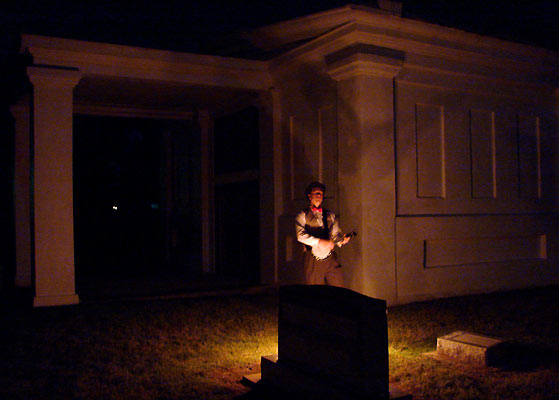
We also took the Talking Tombstones tour last year. See it here.
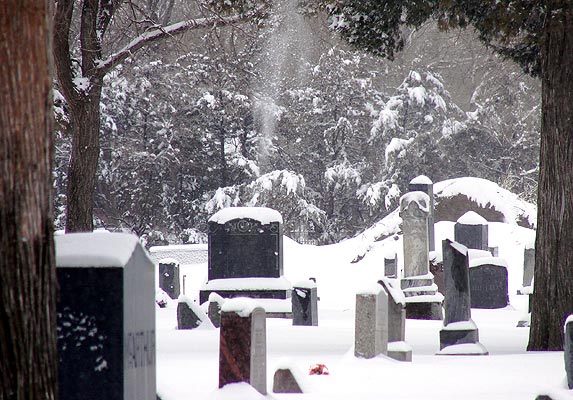
For more of Eastside cemetery, see also Sleeping Under a Blanket.
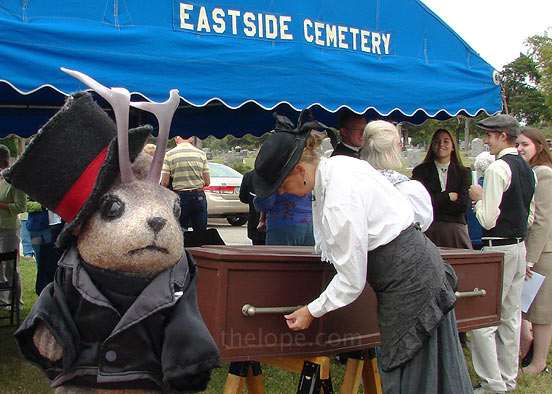
Biographical data on the dear departed is taken from scripts and notes provided by Andrea Springer and Bob Colladay.

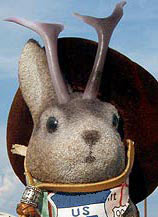
1 Comments:
Love the Talking Tombstones post - thanks for the added detail!
Andrea
Post a Comment
<< Home